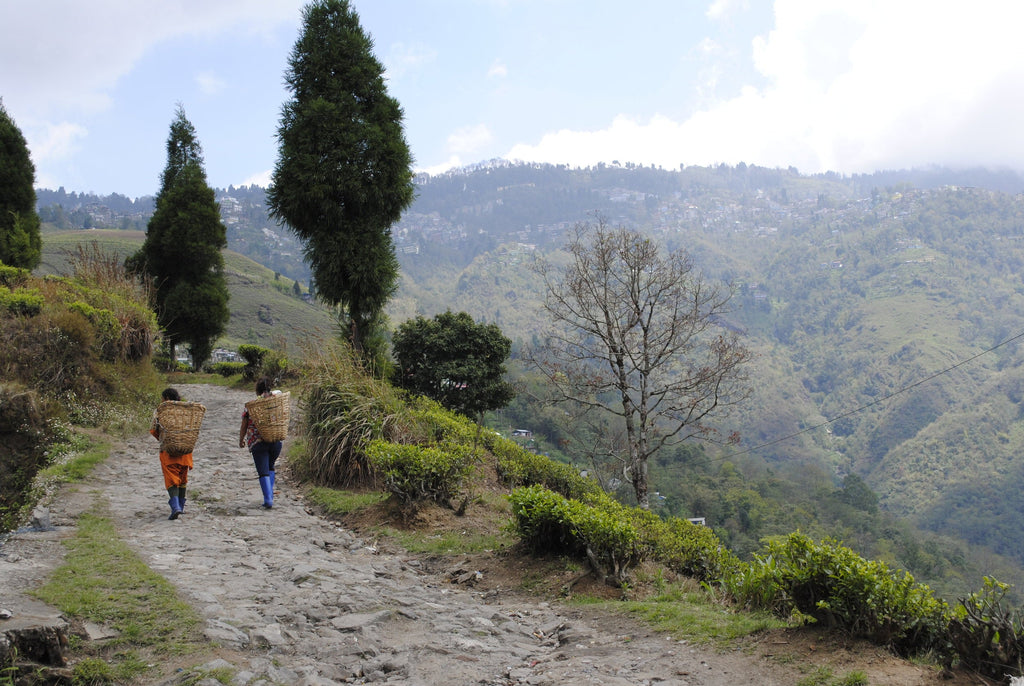All About Darjeeling Tea, the Beguiling Brew of the Himalayas

As high as 6,000 feet above the Dooars plain of West Bengal, Darjeeling’s lush tea estates look as tranquil as zen gardens. On a rare clear morning in the spring, you can see past the rolling green hills all the way to Mount Kanchenjunga, on the border of India and Nepal.
Our friend Chandra, the manager of the Singell Tea Estate, keeps a calm demeanor despite the fact that during production, it’s only a matter of time until some new crisis demands his attention. Freshly picked leaf is coming to the factory twice a day, and after a cloudy early start to the season, his hundreds of workers are racing to keep up with the intake. Making tea well at first flush—the initial picking of the year—is crucial. First flush teas represent a small percentage of a Darjeeling tea farm’s overall yield, but account for a majority of its revenue. These delicate, early spring teas are among the most sought after in the world, and can sell for hundreds of dollars a pound on the wholesale market.
IPOT founder Sebastian Beckwith fell in love with Darjeeling tea over 20 years ago, when he would pass through the gardens on my way to Sikkim to see friends. Since then, he’s traveled to the Himalayan region as often as I can, to reconnect with people like Chandra, meet new managers from across the district’s 87 estates, and, of course, taste the latest harvest. At any garden, the quality of a given tea can change from year to year, and even day to day—not enough rain on that side of the hill, too much sun in the valley, or the departure of a skilled leaf sorter can make the difference between an ordinary Darjeeling tea and a superior one. So every season, we cup hundreds of individual lots, or “invoices” as they’re called in Darjeeling, to make our selections.
But what is Darjeeling tea exactly, and why is it so popular? To begin, it helps to know its origins.

A brief history of Darjeeling tea
Northeastern India is one of the places where the Camellia sinensis tea plant is indigenous, and records and ethnographies in the region document its use as a food and folk medicine hundreds of years ago. As a daily drink, though, tea really only entered Indian culture as a result of the colonial system. The British couldn’t get enough of it (tea, or the colonial system), and even before defeating China in the First Opium War in 1842—which was caused by a trade imbalance due to their insatiable thirst for the Chinese beverage—they had decided to ensure their own supply by cultivating vast gardens of Camellia sinensis var. sinensis in the sunny, low-lying region adjacent to the Himalayas called Assam. The native assamica variety, however, ultimately proved to be more suitable for the tropical environment, and became the type widespread in the region today.
The large-leaf assamica plant yields a bold, brisk, and malty black tea that has become a trademark of Assam. But in the cooler, vertiginous environs of Darjeeling, the small-leaf sinensis variety flourished, and produced a tea with delicate yet complex floral and fruity flavors. These sinensis seeds were pilfered from China beginning in the late 1830s; at that time, China wisely kept tea plants and all knowledge of tea production a state secret. In 1841, Archibald Campbell, a civil surgeon in the Indian Medical Service, first planted sinensis in Darjeeling. A few years later, the British East India Company sent Scottish botanist Robert Fortune to China on a mission to smuggle more tea seeds and tea planters out of the country, so that the British could continue to experiment with a range of tea plants, with the aim of achieving mass production.
You can read a more in-depth history of Darjeeling tea in the excellent Darjeeling, by Jeff Koehler, but suffice to say by the 1850s, the British and the handful of Chinese planters in the region began to successfully produce a distinctive black tea.
Something to keep in mind: While the British colonial system was eventually overthrown by the Indian independence movement, Darjeeling’s tea gardens are more or less run the same way now as they were back then. Workers live on the farm, with the owner providing subsidies for housing, food, healthcare, and education. The processing machines are in many cases over a hundred years old; managers still take notes in leather-bound ledgers and weigh out tea leaves for cupping with an a hand-held brass scale—with a 25-paise coin (now that it’s out of circulation, often taped down to keep it secure) as the standard, which weighs 2.8 grams. Lots are proudly identified by single estates. Indian corporate owners may have replaced British ones, and the once tiny hill stations of Kurseong, Kalimpong, and Darjeeling town are now congested areas, grasping to support growing populations on eroding mountainsides. Yet from a strictly tea perspective, Darjeeling is vibrant and dynamic.






